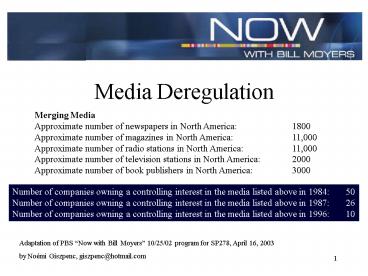Media Deregulation PowerPoint PPT Presentation
1 / 11
Title: Media Deregulation
1
Media Deregulation
Merging Media Approximate number of newspapers in
North America 1800 Approximate number of
magazines in North America 11,000 Approximate
number of radio stations in North
America 11,000 Approximate number of
television stations in North America 2000 Approxi
mate number of book publishers in North
America 3000
Number of companies owning a controlling interest
in the media listed above in 1984 50 Number of
companies owning a controlling interest in the
media listed above in 1987 26 Number of
companies owning a controlling interest in the
media listed above in 1996 10
Adaptation of PBS Now with Bill Moyers 10/25/02
program for SP278, April 16, 2003 by Noémi
Giszpenc, giszpenc_at_hotmail.com
2
Media as an Economic Public Good
- Has positive externalities (information,
entertainment) - Excessive advertising may be a negative
externality - If medium is non-subscription, non-exclusive
- Listeners/watchers can enjoy without paying
- Not true for pay-per-view
- Media are non-rival
- My enjoyment does not diminish yours.
- On the contrary network externalities may
increase yours. - Monopolistic power
- Has effect on public media can raise costs for
consumers (directly or w/more ads), and can raise
costs for advertisers and use cross-ownership à
la Clear Channel, Microsoft
3
Media as a Political Public Good
- Control over public airwaves granted by public
for public interest - Companies have responsibility for more than just
making a profit - To contribute to a healthy public debate
- To present a diversity of views
Undue economic concentration has an adverse
impact on competition, diversity and localism.
When a single competitor, for example, acquires
sufficient market power through consolidation, it
may likely exercise that power to increase
advertising rates, deter entry, disadvantage
rivals, or cause otherwise efficient rivals to
exit from the market and thus deprive the
consumer of independent voices, thereby limiting
the range of information received by the
listening public. Moreover, vigorous competition
among market participants usually compels
competitors to produce a better product, which
directly benefits the listening public. These
concerns are at the core of the Commissions
statutory public interest mandate. --Press
Statement of FCC Commissioner Gloria Tristani,
March 12, 2001
4
Arguments for Deregulation
- FCC Chairman Michael Powell Big is not
necessarily bad. Stations need resources to bring
viewers quality news. - Also, rules outdated predate cable, satellite,
Internet. - Companies say viewers like what they see. Also,
they are trying to preserve free television
Large fixed costs of investment in news, sports,
and entertainment mean they need lots of stations
to be profitable
5
Rules Subject to Change
The Federal Communication Commission is an
independent government organization accountable
to Congress. The FCC regulates "interstate and
international communications by radio,
television, wire, satellite and cable" within
U.S. jurisdiction.
- The FCC is bound by Congress to justify rules
every two years.
- Rules that are under review and likely to change
- No one TV broadcaster can reach more than 35 of
national audience - Newspapers cant own TV or radio stations in
local market, and vice versa - Caps on number of TV, radio stations one entity
can own in a given locality - Ban on 4 major networks combining
6
What the Critics Say
- Conglomerates are already very profitable.
- Consolidation comes at the expense of local
communities, journalism, and advertisers (mixed
evidence on this last one). - Examples of bad local outcomes
- Minot, ND and ClearChannel
- TV coverage of local stories better by small and
mid-size stations (see graph) - Journalism
- Quality see graph
- Fewer choices (but cross-ownership of TV station
with newspaper does boost quality of news).
7
Robot Radios and Chemical Spills
- Jan 18, 2002 A Canadian Pacific train hauling
anhydrous ammonia derailed outside Minot, ND. - A toxic cloud poured from the punctured rail
cars, quickly moving through the Souris River
Valley. One man died and more than 1,000 were
injured in the panicked hours that followed.
When the emergency alert system failed, the
police called the town radio stations, six of
which are owned by the corporate giant Clear
Channel. According to news accounts, no one
answered the phone at the stations for more than
an hour and a half. Three hundred people were
hospitalized, some partially blinded by the
ammonia. Pets and livestock were killed.
http//www.nytimes.com/2003/02/20/opinion/20THU4.h
tml February 20, 2003The Trouble With Corporate
Radio The Day the Protest Music Died By BRENT
STAPLES
8
(No Transcript)
9
(No Transcript)
10
Determinants of Quality
- Study design team said a local television
newscast should - 1) cover the whole community
- 2) be significant and informative
- 3) demonstrate enterprise and courage
- 4) be fair, balanced and accurate
- 5) be authoritative
- 6) be highly local.
- Study methodology
- how many topics are covered (1)
- the degree to which stories touched on underlying
themes, issues or trends (2) - how much effort was demonstrated in reporting the
story (3) - how many sources and points of view each story
contains (4) - who the sources are (5)
- the degree to which stories are made locally
relevant (6)
11
Public awareness of FCC deregulation Survey

